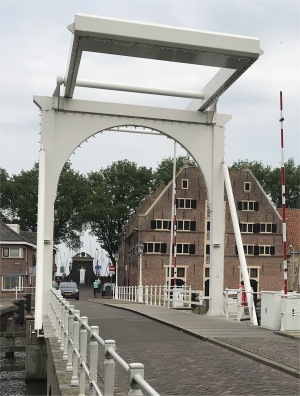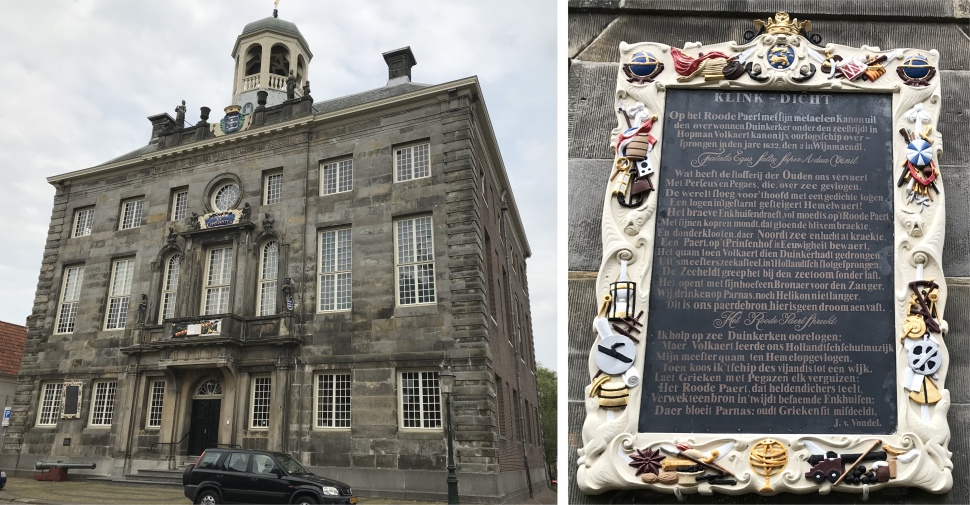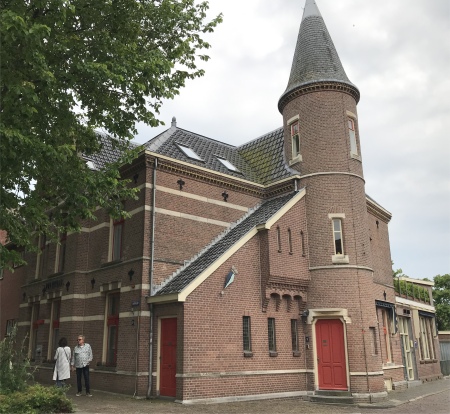We decided to head across the Ijsselmeer to Enkhuizen. Just as Rex started the engine up, and I went to the bow to handle the ropes, our German neighbour started a conversation. "You are going now?" "Yes, we are sailing across to Enkhuizen today, and later to Hoorn." "Hoorn is a lovely place," he replied. "Yes, we have been there a couple of times before," I responded. "But you must be careful this time of year in the Markermeer. In the shallow waters near Monickendam, Edam and Hoorn, a weed grows and floats on the water. It can damage your screw," which I took to mean either the propeller or the water inlet impeller. "Also, on the buoyed route between Lemmer and Amsterdam there is a new wreck, and the channel becomes very narrow." I could see out of the corner of my eye Rex bouncing up and down anxious to leave. I thanked the chap profusely, bade our farewells, and cast off.
Soon we were sailing in a Force4/5 with the jib only. 1m high waves crashed up our stern. It was a cracking sail with the wind behind us; a "soldiers wind" according to Rex. Umpteen other yachts were heading in the same direction, obviously all heading to Enkhuizen or its sluis. We learned later the reason for so many yachts out on the Ijsselmeer, it was a public holiday.
 Zwaanstraat Bridge over the Oosterhaven |
After 4 hours, we arrived at Enkhuizen, and this time opted for the Compagnieshaven Marina, where we had stayed in the past. This marina was much bigger than the Buyshaven, with better facilities.
Thankfully the marina was clearly laid out, pointing visitors down a long fairway to a pontoon with a hut on it. As we gently chugged up to it, a smartly dressed lad with a white shirt and clipboard popped out of the hut to greet us in Dutch, and ask for the dimensions of the boat. I shouted the information across, he scanned his clipboard, and assigned a berth for us. We moored effortlessly into a box. I soon popped down to the harbour master's office to pay our dues. On the way back, an elderly couple were pointing out to their grandson a couple of grebe chicks on their mother's back.
An endless stream of boats followed us into the marina, and were also efficiently appointed berths for the night; quite a slick operation I thought. One very large yacht seemed to be heading towards the hammerhead next to where we were berthed. I spotted the Dutch skipper and pointed to this hammerhead; he nodded. Rex and I climbed onto his proposed berthing place and took his ropes. He was very thankful, he was sailing single handed. "I haven't really done anything," piped up Rex. The chap laughed. "Welcome to Holland," was my greeting. "Welcome to Europe," he chuckled, "or for the time being." He burst into laughter again, in a good natured way.
Rex still wasn't feeling 100%, so he opted to lie down for a rest while I went for a hike into the centre of town to take in the sights again. I crossed the Oosterhaven by the Zwaanstraat Bridge and shortly arrived at the Stadhuis.
 Stadhuis |
 St Pancraskerk |
The tall St Pancraskerk towered above the town. Dating from the early 15th century, the tower was built in 1450 and heightened between 1518 and 1526 by the addition of an octagonal upper section and an onion dome.
 Former Post Office |
Pointing to St Pancraskerk, he commented, "That church was paid for by the fishermen." I responded, "I think I remember that. The fishermen paid for it, since a light would be lit at the top of it to serve as a beacon." The chap then went on to tell me, "There were two types of people in Enkhuizen: fishermen and farmers. There is another church in the town, with the spire made out of wood now on the ground." "Yes, a lady told me a few years ago that when building the church, they decided the church would not withstand the huge weight of the bells. Therefore a separate tower was built on the ground." "They could not afford to carry on and build a brick tower, so they chose wood instead," was his version.
 St Gomaruskerk |
 Weeshuis |
 Varied Architectures |
As it started to pour, we went around the corner to a charming, warm restaurant, the Grand Cafe Restaurant van Bleiswijk., and enjoyed onion soups and salads. It was still pouring when we left and returned to Duonita. The boat was now filling up with wet and damp clothing.
